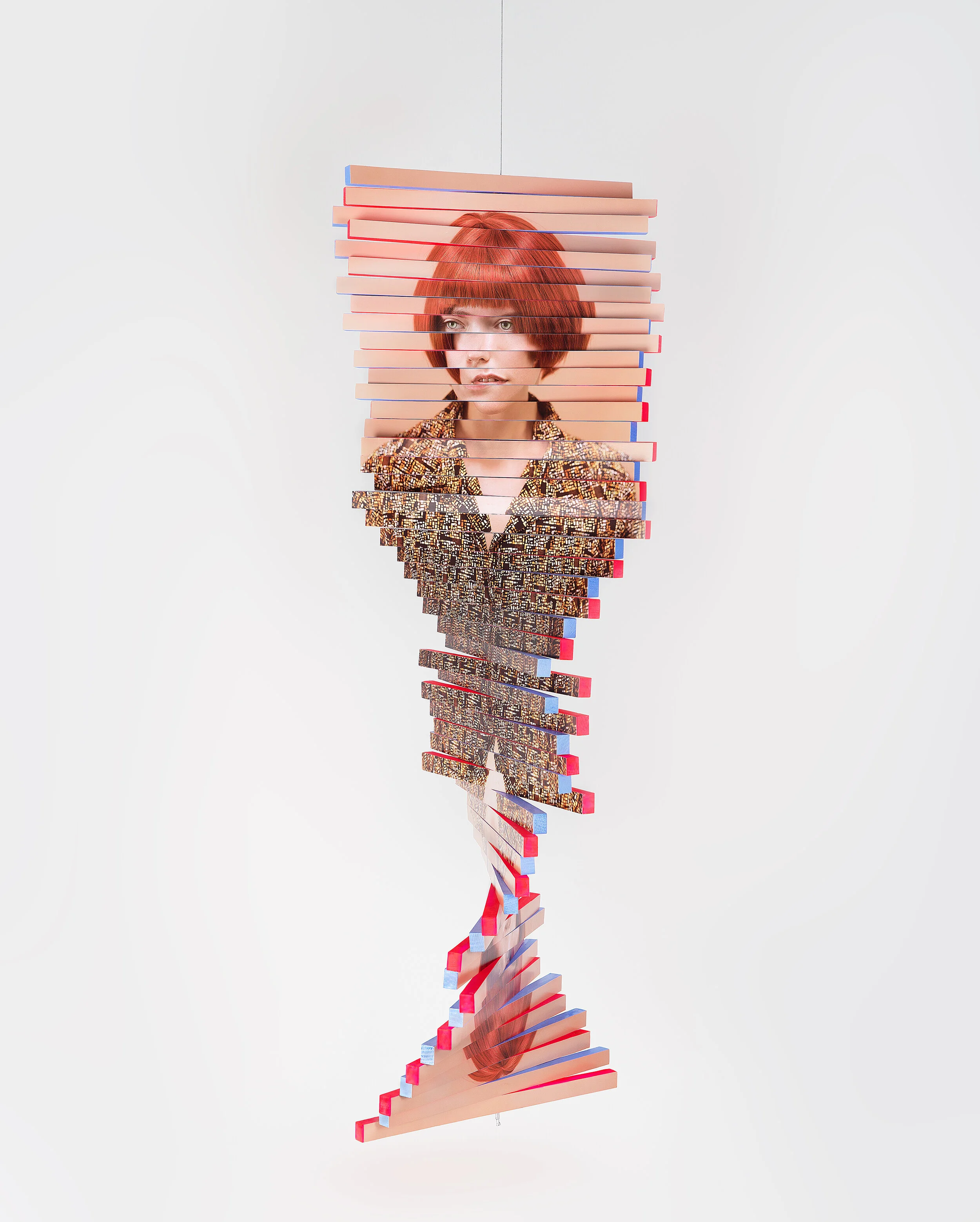In the Studio with Karen Navarro
Karen Navarro
is an Argentinian artist working and living in Houston. Having studied Fashion Design and Photography, Navarro’s work uses “deconstructed photography” to explore identity through layered pieces which incorporate both photography and a more sculptural element. Karen is the cover artist for Volume 12, and spoke with Alison Poon about social media’s influence on identity, an artist’s duty, and creating enticing images to challenge society’s perceptions.
INTERVIEW WITH KAREN NAVARRO
Alison: Your background is in fashion and photography; how did this transform into an artistic practice?
Karen: Over time my artistic journey has taken different routes. I transitioned from fashion design to fashion photography and from fashion photography to fine art photography and mixed media. From each practice I brought something into my art. For example, when I was studying fashion design at the University of Buenos Aires the curriculum was exceptionally comprehensive. I not only learned about fashion and technical design skills but also about art history, philosophy, sociology, and above all, it taught me and helped me to develop critical thought. When I relocated to the U.S. I had to pivot in order to keep working in the creative field, so, I started doing fashion photography. I wasn't expecting to become an artist, but one thing led to another and I ended up doing what I love the most. In photography, I found a passion and a medium that allows me to express myself in a way where I can create my own worlds with no restrictions, norms, or rules to follow. Nonetheless, I found myself wanting to experiment more- to create work that is made with my hands- which is the type of work I am exploring and creating today. Allowing myself to grow and shift directions is a form of evolving for me.
Alison: Your work often discusses cultural identity; do you think your own experiences moving from Buenos Aires to Houston has influenced this?
Installation shot, Karen Navarro
Karen: Definitely, although I always hovered around the topic of the Self, it was more in a philosophical sense. Before migrating to the United States, it was never a question how I selfidentify. Being an immigrant and how I am identified by others has posed questions about my own identity and my sense of belonging. However, when living in Argentina this never mattered to me to the extend it does today, because before I was just Karen, an Argentine living in her country. This has led me to want to know more about my ancestral history and try to reconstruct my own identity. When I am creating a piece there is something in the process that mirrors my process of trying to reconstruct my identity; how I try to puzzle the pieces together, how I accommodate and rearrange trying to make sense out of it, or maybe just trying to reflect the confusion it causes me.
Alison: Social media is an important part of your work both conceptually and practically, how do you use social media platforms within your work?
Karen: Social media is such an important part of our current times, how we communicate and relate has changed. Historically this has been in the physical world and now, it is in the digital world. As an artist I feel the responsibility to reflect the times we are living today, because what concerns me is that it’s the artists' duty to create dialogues. For this reason, I not only use social media as a direct tool to cast people for photo projects but I use it conceptually as well. In the series of portraits “El Pertenecer en Tiempos Modernos (Belonging in Modern Times)” I explore how self-representation through social media creates belonging. I do believe that the online “us” is an illusion of ourselves hence the collages are deconstructed.
Alison: The colors and compositions of your original photographs seem very carefully thought through. What informs these decisions?
Karen: In general, I use a lot of blue and pink because these colors are socially associated with gender. The generally accepted rule is "blue is for boys and pink is for girls", although historically blue was usually worn by girls and pink was the preferred shade for boys but in the 19th century this changed. I find absurd how colors can become a loaded signifier of gender, value or identity and I’m very interested in challenging these socially constructed notions. In the series “El Pertenecer en Tiempos Modernos” I used these colors because those are the colors of the social media logos. Blue is for Facebook and for many other social media logos, such as Twitter, and pink is for the Instagram logo. I asked the participants to bring one accessory and an article of clothing that was either blue or red, depending on the platform from which communication was initiated. If we connected via Facebook, they would bring something blue and vice versa. I decided that unifying the participants in this particular color scheme would bring them together in a way that emphasized a sense of belonging.
Alison: You talk about your work existing in-between photography, collage and sculpture. Could you talk a little bit about your process?
Karen: Before I make an image or create a work, I do a lot of mind mapping and planning. But usually, ideas change throughout the process of creating a piece. I have found that the more I work the more ideas I get or solutions I find for the pieces I am creating or want to create. For this reason, I am constantly working on something, sketching, or looking for materials or testing them, developing an idea, or actually fabricating the piece. If am working on collages, generally I start from my own digital photographs. Then I cut and reassemble the images to create a new form or a new character. I like to refer to this as "constructed portraits" since I like to push the boundaries of photography and occupy that space in between practices. For example, if I am making a sculpture, I cut the photographs and reconstruct them, adding wood, paint, resin, and other materials. Metaphorically, adding physical properties to the work to create multiple layers refers the complexity of identity.
Alison: Your work aims to challenge the audience’s perspectives about identity, categorisation and the way we portray ourselves. Have you also found your own perspectives challenged during the process?
Karen: I am always learning and expanding my understanding. When I start a body of work, I don’t have all the answers and it’s usually through the research process and the interaction with the people that I find my own perceptions tested or challenged. It’s the knowledge what sometimes makes us change our thinking. I don’t consider myself an expert rather someone who knows so little compared to the knowledge available in the world. The work is born from personal experiences or self-referential questions. I feel that I can only speak for myself and my own experiences, but I aim that the work resonates with a larger group of people. I am before anyone else the first person in the audience the work is for, because I see the work as a process, a conversation where questions and answers happen. In my work I don't offer answers because I don't believe in absolute truths, rather, I bring you close to the answers. And, I always do it in an inviting way by using colors and an intended aesthetic to seduce you to think and question and come up with your own answers. Hopefully the right ones.
Alison: How has Covid-19 affected you and your studio work?
Karen: It actually hasn’t affected me that much in regard to productivity. This time of self-isolation is somewhat normal for me. I used to spend most of my time alone working at the studio or working from home when I have computer work. I adapt very easily to situations, and I become very imaginative and become a problem solver when I am restricted. I think that this period has in fact, given me the opportunity to pause, rethink, and investigate more. But more importantly “to rest”.




